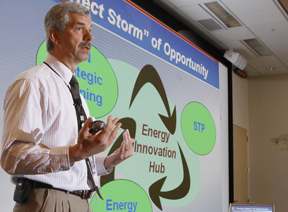
That’s a tall order, but it’s the context in which Sandia’s Energy, Resources, and Nonproliferation (ERN) Strategic Management Unit is funding a “big idea” proposal that it hopes will engage a broad community and influence national decision makers to lead the country down the path of American competitiveness, energy security, and environmental stability.
The proposal is being developed under an ERN-funded effort. It will initially focus on a Low-Carbon Transportation Energy concept and examine the value proposition and business model that could be employed as a public/private endeavor. Though the ERN’s management team is calling it the “Big Idea,” Terry Michalske (8300) and Margie Tatro (6200) explain that the Low-Carbon Transportation Energy investment is actually part of a much grander vision.
“This may be the first ‘big idea,’ but it’s really meant to plant the seed for an even bigger idea, one that we hope will lay the groundwork for a federal initiative,” says Terry.
Starting with the Low-Carbon Transportation Energy concept, the ERN’s “board of directors” aims to advance a national framework for energy policy that supports what the federal government might call the National Energy Innovation Initiative (NEII). “Other topics, such as electric grid integration and nuclear energy security, offer potential for other innovation ‘hubs’ that could conceivably be led by Sandia,” says Margie.
When successfully developed, the low-carbon proposal will be presented to DOE decision makers as a potential model for an energy innovation hub, another important component to the NEII idea. Energy innovation hubs would have a clear, distinct, outcome-oriented focus (low-carbon transportation energy and renewables grid integration, for example) and would anchor the NEII and promote international knowledge sharing.
CRF and CINT demonstrate new approach
Two distinct examples — one with a rich history, the other with a more recent but no less successful blueprint — inspired ERN management to think differently about how Sandia works and motivated DOE to explore models that are open and inclusive.
“DOE’s leadership believes it needs to develop a more effective framework for linking science and innovation,” says Terry. To that end, the Combustion Research Facility (CRF) and its more than 25 years of success in information sharing, leading-edge science, and commercial partnerships offers one viable model, one that DOE uses as an example of a facility where scientists and engineers work together to bridge the “valleys of death” in technology development efforts, he says.
“Securing America’s energy future will not be possible through technology development alone,” says Julia Phillips (1100). “Fundamental scientific inquiry is needed to provide the understanding that will enable revolutionary technologies we can’t imagine today. We need a mechanism, such as the Energy Innovation Hubs, to accelerate the translation of scientific discoveries to technologies,” she says.
Similarly, the recent success of Sandia’s Center for Integrated Nanotechnologies (CINT) project presents another example that Sandia’s ERN leadership is drawing upon as it considers how to advance a new national energy initiative. CINT is one of five Nanoscale Science Research Centers (NSRC) that, together with other elements, form the National Nanotechnology Initiative (NNI). That endeavor, launched under the Clinton administration, addresses the diverse aspects of nanoscience and technology. Terry likens each NSRC concept to an energy innovation hub, and the NNI to NEII.
“The CRF and CINT have both proven to be invaluable resources for universities, other research institutions, and the commercial sector,” says Terry. “They are the cornerstones of their respective disciplines — combustion research and nanoscience — and, in their own ways, have helped jump-start the science and research activities devoted to each of those fields. Similarly, a low-carbon transportation energy program, developed as one of several energy innovation hubs, could be an important piece of the overall energy puzzle.”
Andy McIlroy (8350) spearheaded the Low-Carbon Transportation Partnership concept, which was selected from a handful of other ideas. He says the other proposals, themes of which included dedicated research programs into the electric grid, renewable energy sources, and nuclear power, are also viable energy innovation hub ideas and could very well be revisited by Sandia in the future.
“It makes sense right now to focus on the transportation sector,” says Andy. “Sandia is already considered a leader in combustion science and a growing leader in alternative fuels development. We have demonstrated a unique ability to integrate science into the marketplace. That’s what we hope to achieve with the low-carbon transportation energy idea.”
The Transportation Energy Innovation Hub proposal that Andy, Ellen Stechel (6338), and others are developing will contain a number of key elements, including a focus on knowledge-generation and a workable path to innovation. It will also feature a private sector leadership component (currently being identified) that is integrated with DOE science and energy program activities. Other elements will include:
- A clear focus on transportation energy systems
- An open network knowledge community that includes academia and the private sector
- A regional focus that connects with and strengthens local government, academia, and private sector partners
- The assemblage of unique facilities and expertise that provides value to the broader community of scientists and engineers
- A core set of resources, facilities, and expertise
- A campus design that promotes success for key elements of a transportation energy innovation hub
The hope, says Terry Michalske, is that a successful low-carbon transportation energy investment will position Sandia as an early “pilot energy innovation hub” and be used to demonstrate the concept to DOE. Such initial successes, he adds, will help build acceptance for the “energy innovation hub” model and lead to follow-on strategies in anticipation of a future, large-scale DOE program.